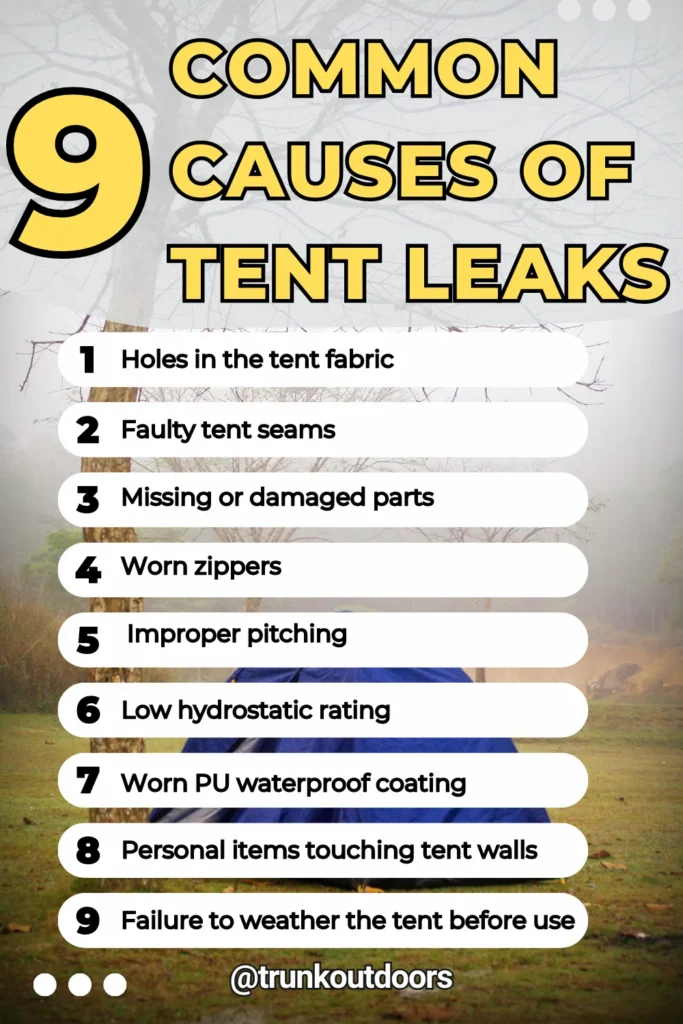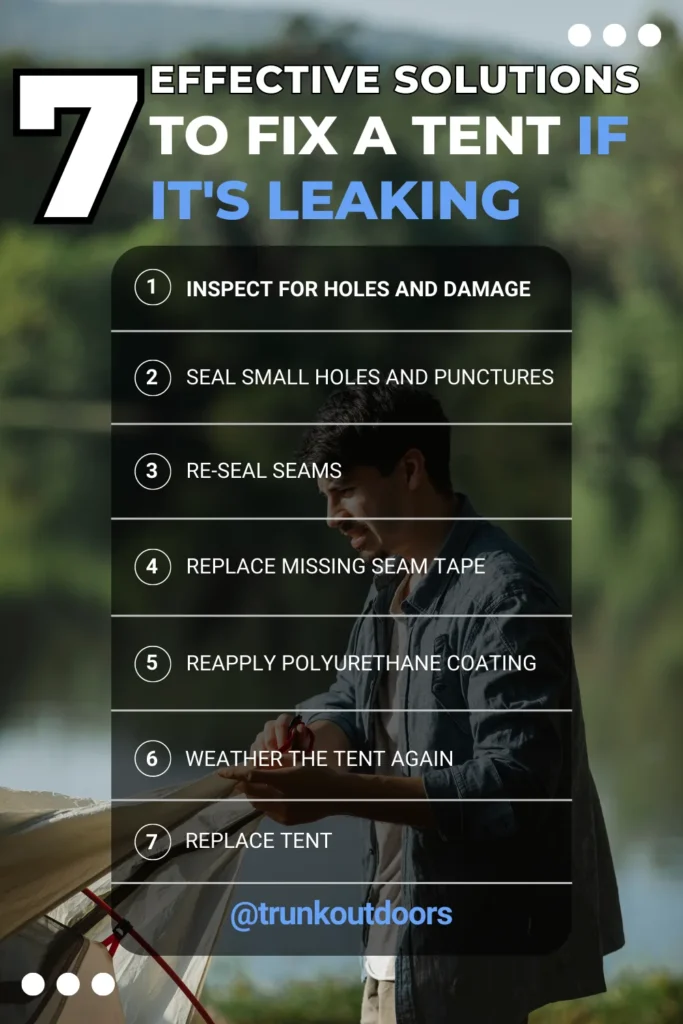Why Do Tents Leak? Causes and Effective Solutions
Are you tired of having your camping trips ruined by a leaking tent? A leaking tent can be a camper’s worst nightmare, leaving you vulnerable to the elements and potentially damaging your gear.
But fear not, as we’re here to help you prevent tent leaks and enjoy a hassle-free outdoor adventure.
In this article, we will delve into the question: Why do tents leak? We’ll uncover the causes of tent leaks and provide you with practical solutions to stay dry and comfortable while camping in the rain.
Short Answer:
Tents can leak due to various reasons such as poor waterproofing, wear and tear, condensation, and improper setup. Understanding these factors is essential for preventing leaks and ensuring a comfortable camping experience.
So, let’s dive in and discover how you can make the most of your next camping trip without worrying about tent leakage.
Is it condensation or a leaking tent?
It can sometimes be difficult to tell the difference between condensation and an actual leak in a tent. Here are some things to look for:
a) Condensation:
- Wetness is uniform: Droplets and wetness tend to form evenly across interior tent surfaces due to moisture in the air condensing on the tent fabric.
- Wetness begins on the inner tent surfaces: Condensation forms on the inside of the tent walls and ceiling where there is the coldest surface for the moisture in the air to condense on.
- Wetness occurs when conditions are right: Higher humidity and colder temperatures at night lead to more condensation, especially if there are multiple people inside the tent breathing out moisture.
- Wetness disappears during the day: As temperatures rise during the day, condensation evaporates and disappears.
b) Actual Leak:
- Wetness is localized: Water enters through a specific hole, seam, or damaged area and tends to pool in one spot.
- Wetness begins on the outer tent surfaces: Water is coming through the outer waterproof fabric layer.
- Wetness occurs with any amount of rain: An actual leak will let water in regardless of humidity level inside the tent.
- Wetness persists after rain stops: Water that has leaked into the tent remains pooled in specific areas, even after rain stops falling.
Related Topics:
Common Causes of Tent Leaks

There are a few common reasons why a tent can start leaking:
- Holes in the tent fabric
The most obvious cause of a tent leaking is when there are holes in the tent fabric caused by accidents, animals, sharp objects, rocks, branches, etc.. These holes allow water directly to seep through the tent walls.
- Faulty tent seams
Over time, the seams of a tent can start to come apart, especially at high stress points like where poles attach. This can allow water to seep through.
- Missing or damaged parts
Missing poles, stakes, guylines, or pole sleeves can result in an improperly shaped tent that does not shed water well.
- Worn zippers
Zipper teeth can saw through the waterproof liner holding them in place, creating an open area for water to enter.
- Worn polyurethane waterproof coating
Over time, weather conditions and detergents can damage the polyurethane coating on the tent fabric which makes it less water resistant and allows leaks.
- Low hydrostatic rating
The hydrostatic rating indicates how water resistant the tent fabric is. A lower rating under 2000mm means the tent is less resistant to heavy rain and more prone to leaking.
- Personal items touching tent walls
When items inside the tent are touching the walls, it creates channels for water to enter the tent through a process called capillary action.
- Failure to weather the tent before use
Some tents need to be “weathered” before use by spraying them with water a few times. This helps the seam stitches to expand and close tiny holes to reduce leakage.
- Improper pitching
If a tent is not pitched tightly with all guylines secured and poles fitting snugly, it can cause sagging fabric and pooling water.
Related Topics:
7 effective solutions to fix a tent if it’s leaking

You can often fix a leaking tent yourself. Here are some steps you can take:
- Inspect for holes and damage: Check the tent fabric, seams and zippers closely for any holes, rips or punctures. This is often the main cause of leaks so fixing damage can solve the issue.
- Seal small holes and punctures: Use tent sealant or fabric sealant to cover and seal any small holes or punctures in the tent fabric. Let the sealant dry completely before using the tent again.
- Re-seal seams: Apply seam sealer to any open or loose seams. Seam sealer is a liquid or tape designed specifically for sealing tent seams.
- Replace missing seam tape: If part of the seam tape is missing, you can buy replacement seam tape and reapply it to cover the open seams.
- Reapply polyurethane coating: If the polyurethane waterproof coating is worn or flaking, you can buy a polyurethane spray and reapply a fresh coat to the tent fabric.
- Weather the tent again: Even if a tent was previously weathered, repeating the process after repairs can help identify any issues you missed and allow the seams to expand again.
- Replace tent: If none of the above fixes work and your tent continues to leak, it may be time to replace your worn out tent. New tents will have stronger seams, better waterproof coatings and puncture-resistant fabric.
For detailed instructions and recommended products, check out this resource on How to Waterproof a Tent.
Which tents will prevent leakage?
There are a few types of tents that are more likely to prevent leakage:
- Free standing dome tents: These tents have their own structural shape without needing to be staked down. The rigid poles and shape make them more resistant to water penetration.
- Single wall tents: Traditional tents with one main layer of fabric. They tend to have heavier-duty, more water resistant materials and additional seam sealing.
- Four season tents: Designed for use in all weather conditions, they have the most advanced waterproofing technologies like fully taped seams and breathable but waterproof fabrics.
- Premium brand tents: Higher end tents from reputable brands often have more attention to detail in construction and waterproofing. Their seams, coatings and fabrics tend to be of higher quality.
- Tents with a high hydrostatic head rating: A high hydrostatic head rating of at least 2000mm means the tent fabric has been tested to resist more water pressure before leaking. The higher the rating, the more waterproof.
- Tents with full floor coverage: Tents where the full floor has water resistant fabric help prevent leaks from damp ground underneath.
Overall, tents designed for more extreme weather conditions and made with high quality materials from established brands tend to be the most resistant to leakage. But proper setup, seams and care are also important factors.
Check out these 11 Best Waterproof Tents for Heavy Rain That’ll Keep You Dry.
FAQs
Why can’t you touch a tent when it’s raining?
When it’s raining, any contact with the walls creates channels for capillary action to pull water into the inner tent. So, Avoid touching the tent’s interior during rain to prevent water from seeping in.
Do canvas tents need waterproofing?
While traditionally made from absorbent cotton canvas, modern canvas tents still benefit from waterproof coatings to maximize their water resistance and durability, especially for withstanding heavier rains and prolonged use. All canvas tents should be treated with a waterproof coating when new and reapplied periodically.
Why is my tent wet when it didn’t rain?
Your tent may be wet even without rain due to condensation from your breath and the air inside the tent accumulating on the tent walls and seeping in through holes or porous fabric. Damage or leaks in the tent also allow external moisture from a damp groundsheet to be absorbed.
Conclusion
Understanding the reasons behind tent leaks is the first step toward preventing them.
By addressing issues such as insufficient waterproofing, seam sealing, condensation buildup, poor tent design, and damage, you can significantly reduce the risk of leaks during your camping adventures.
Regular maintenance, proper tent setup, and investing in high-quality gear are key to ensuring a dry and enjoyable camping experience.
So, gear up, waterproof your tent, and embrace the beauty of nature without worrying about leaks dampening your spirits!